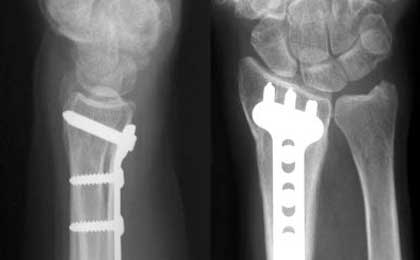While some simple or “closed” fractures (a break in the bone without piercing through the skin) are repaired with “closed reduction,” which is the non surgical, physical manipulation of the fractured bone, some require repair with either external fixation or internal fixation.
External fixation includes casts, splints or other devices, to maintain proper alignment between the broken pieces while the body works to repair the bone. Internal fixation requires the surgical placement of metal pins, Kirshner wires (K-wires) or plates and screws to achieve proper realignment.
The type of surgical repair of both simple as well as open or “compound” fractures (a break in the bone, which also pierces through the skin) depends on the extent of the break and any other damage to surrounding ligaments, tendons and nerves that may have occurred during the injury.
Following a thorough review of your x-rays and possibly an MRI (magnetic resonance imaging), Dr. Jafarnia determines which approach is best.
Understanding the type of fracture and other damage to the area are key. Aside from simple/closed fractures and open/compound fractures, there are several other types of fracture classifications that will determine the most effective type of fracture treatment.
Other types of fractures include:
- Transverse Fracture – a break at right angles to the long axis of the bone.
- Greenstick Fracture – a break on one side of the bone resulting in a bend on the other side.
- Comminuted Fracture – a break that results in three or more bone fragments.
The hand and upper extremity internal fixation device systems today are designed to conform to the delicate contours of the hand, wrist and elbow – securing bones while posing minimal disturbance to surrounding soft tissue. While the size of the fixation appears larger on an x-ray, the small plates are often comparable to the size of a dime or paper clip – with tiny screws and pins generally placed using special customized magnification lenses known as Loupes.
Postoperative hand and upper extremity fracture treatment may entail rehabilitation and work with an occupational therapist.Early movement will reduce stiffness and ensure a more rapid return of full range of motion and limb strength.


